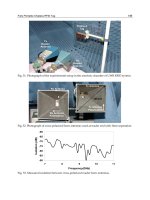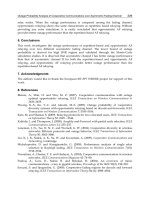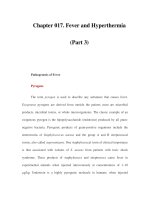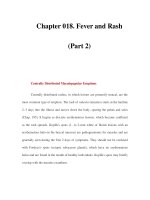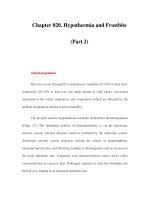Chapter 058. Anemia and Polycythemia (Part 9) pot
Bạn đang xem bản rút gọn của tài liệu. Xem và tải ngay bản đầy đủ của tài liệu tại đây (48.66 KB, 5 trang )
Chapter 058. Anemia and
Polycythemia
(Part 9)
Figure 58-17
The physiologic classification of anemia. CBC, complete blood count.
In the first branch point of the classification of anemia, a reticulocyte
production index > 2.5 indicates that hemolysis is most likely. A reticulocyte
production index < 2 indicates either a hypoproliferative anemia or maturation
disorder. The latter two possibilities can often be distinguished by the red cell
indices, by examination of the peripheral blood smear, or by a marrow
examination. If the red cell indices are normal, the anemia is almost certainly
hypoproliferative in nature. Maturation disorders are characterized by ineffective
red cell production and a low reticulocyte production index. Bizarre red cell
shapes—macrocytes or hypochromic microcytes—are seen on the peripheral
blood smear. With a hypoproliferative anemia, no erythroid hyperplasia is noted in
the marrow, whereas patients with ineffective red cell production have erythroid
hyperplasia and an M/E ratio < 1:1.
Hypoproliferative Anemias
At least 75% of all cases of anemia are hypoproliferative in nature. A
hypoproliferative anemia reflects absolute or relative marrow failure in which the
erythroid marrow has not proliferated appropriately for the degree of anemia. The
majority of hypoproliferative anemias are due to mild to moderate iron deficiency
or inflammation. A hypoproliferative anemia can result from marrow damage, iron
deficiency, or inadequate EPO stimulation. The last may reflect impaired renal
function, suppression of EPO production by inflammatory cytokines such as
interleukin 1, or reduced tissue needs for O
2
from metabolic disease such as
hypothyroidism. Only occasionally is the marrow unable to produce red cells at a
normal rate, and this is most prevalent in patients with renal failure. With diabetes
mellitus or myeloma, the EPO deficiency may be more marked than would be
predicted by the degree of renal insufficiency. In general, hypoproliferative
anemias are characterized by normocytic, normochromic red cells, although
microcytic, hypochromic cells may be observed with mild iron deficiency or long-
standing chronic inflammatory disease. The key laboratory tests in distinguishing
between the various forms of hypoproliferative anemia include the serum iron and
iron-binding capacity, evaluation of renal and thyroid function, a marrow biopsy
or aspirate to detect marrow damage or infiltrative disease, and serum ferritin to
assess iron stores. Occasionally, an iron stain of the marrow will be needed to
determine the pattern of iron distribution. Patients with the anemia of acute or
chronic inflammation show a distinctive pattern of serum iron (low), TIBC
(normal or low), percent transferrin saturation (low), and serum ferritin (normal or
high). These changes in iron values are brought about by hepcidin, the iron
regulatory hormone that is increased in inflammation (Chap. 98). A distinct
pattern of results is noted in mild to moderate iron deficiency (low serum iron,
high TIBC, low percent transferrin saturation, low serum ferritin) (Chap. 98).
Marrow damage by drugs, such as the antiretrovirals used to treat HIV infection,
infiltrative disease such as leukemia or lymphoma, or marrow aplasia can usually
be diagnosed from the peripheral blood and bone marrow morphology. With
infiltrative disease or fibrosis, a marrow biopsy is required.
Maturation Disorders
The presence of anemia with an inappropriately low reticulocyte production
index, macro- or microcytosis on smear, and abnormal red cell indices suggests a
maturation disorder. Maturation disorders are divided into two categories: nuclear
maturation defects, associated with macrocytosis and abnormal marrow
development, and cytoplasmic maturation defects, associated with microcytosis
and hypochromia usually from defects in hemoglobin synthesis. The
inappropriately low reticulocyte production index is a reflection of the ineffective
erythropoiesis that results from the destruction within the marrow of developing
erythroblasts. Bone marrow examination shows erythroid hyperplasia.
Nuclear maturation defects result from vitamin B
12
or folic acid deficiency,
drug damage, or myelodysplasia. Drugs that interfere with cellular DNA
metabolism, such as methotrexate or alkylating agents, can produce a nuclear
maturation defect. Alcohol, alone, is also capable of producing macrocytosis and a
variable degree of anemia, but this is usually associated with folic acid deficiency.
Measurements of folic acid and vitamin B
12
are key not only in identifying the
specific vitamin deficiency but also because they reflect different pathogenetic
mechanisms.


